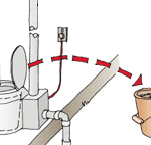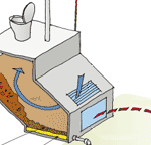Water
Water use, sustainability, and efficiency by choosing quality systems and materials, and providing environmentally friendly solutions.
Types of composting toilet
Composting toilets may be batch type or continuous.
BRANZ does not recommend self-designed composting toilets. A range of manufactured composting toilets is available – these have the benefit of research and development input and have been tested over many years.
Batch-type units
Most small self-contained composting toilets are of the batch type. These have two or more bins. When one bin is full, it must be moved to a suitable place (generally outside) to allow composting to be completed. This generally takes 5–6 weeks. The material is buried, an empty bin replaces the full one and the process is repeated.
They generally do not have the underfloor space requirement of continuous systems, which makes planning easier particularly if more than one toilet is required
Batch type systems must be vented and may:
- be heated
- have mechanical ventilation that requires an electrical connection – 12-volt models are available and power consumption is generally low
- require a vent pipe
- require a connection to an on-site blackwater outfall for separated urine
- require the toilet room to be maintained at a regular temperature.
Continuous systems
Continuous systems have one chamber where all waste is received and stored until composting is completed. The finished compost is removed and buried.
A continuous system requires an underfloor space, and each pan must have its own chamber. (Therefore, having more than one toilet may be difficult and expensive.)
They may require:
- a positive air pressure in the toilet room to avoid smells
- an air inlet and exhaust which may be driven by convection, electric fan or solar heat (generally power consumption is low)
- a means of draining excess liquid
- access to a hatch for removal of finished compost
- the addition (by the users) of organic bulking agents such as sawdust to aid the decomposition process.



